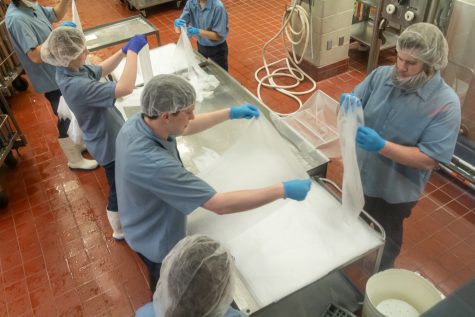Robotic pollinator could decrease reliance on bees
Robot will use AI software, electrostatic sprayer to locate, pollinate flowers with more precision
The robot and its electrostatic sprayer will be tested in a lab before they are tested in the field next spring.
June 30, 2022
WSU researchers are creating a robotic pollination system to stabilize the pollination process and decrease farmers’ dependence on bees.
The engineering and horticulture science departments will collaborate to develop an artificial pollination system that is more precise, said Matthew Whiting, professor at the Department of Horticulture Research and Extension Center.
“We hope to identify flowers receptive to artificial pollination, develop a vision system with various cameras [to] find those flowers and then direct a robotic arm [to] pollinate the flowers,” Whiting said. “That’s the short-term [goal].”
He and his team are examining optimum times for pollination when the robotic system would apply pollen to flowers, he said. Using this system will decrease reliance on bees and increase the sustainability of pollination.
“From a farmer’s point of view, the potential to remove so much biological variability in pollination and to set the crop has tremendous potential advantages,” Whiting said. “We can be more precise and more consistent, [which] would lead to a more sustainable production of high-value food crops.”
Pollinator populations are decreasing due to environmental conditions.
One global concern is Colony Collapse Disorder, the collapse of honeybee colonies due to the lack of worker bees, he said. Another issue is biological variability in the weather and climate. Bees are inactive in cold temperatures, during which flowers bloom. The flowers remain unpollinated due to the inactive bees.
Robotic pollinators provide an alternative to bees and other pollinators, Whiting said.
“There is just so much biological variability when you use bees as pollinators, and this past spring was a really great example of that,” he said. “The cherry trees in the state of Washington began to flower, but it was too cold for pollinators to fly. All these flowers were opening, and there were no pollinators pollinating.”
Although the project aims to decrease dependency on bees, it will not eliminate the need for these pollinators, Whiting said.
“The motivation here is certainly not to get rid of the bees,” he said. “[We] would rather have less dependence on these managed pollinator communities and introduce more precision into the process.”
During the artificial pollination process, pollen is sprayed onto the flowers to maximize efficiency and consistency. Pollen is first collected and put into a liquid suspension, where particles are suspended in liquid form. The pollen is then sprayed using an electrostatic sprayer, which gives the particles a positive charge. The positive particles are attracted to the negative charge of the stigma tip, Whiting said.
“These positively charged droplets are electrostatically drawn to the target because of the opposite charge,” he said. “We get improved deposition, efficiency and efficacy by using an electrostatic sprayer.”
Changki Mo, associate professor in mechanical engineering at WSU Tri-Cities, is working on the end effector sprayer, or robot hand. Testing of the sprayer is done separately before it is integrated with the robot.
Manoj Karkee, associate professor at the Center for Precision and Automated Agricultural Systems. He is researching the machine’s vision system in addition to integrating the robot and sprayer for field testing.
The robotic pollinator uses a vision system and artificial intelligence software to identify and locate target flowers, position itself accordingly and apply the correct amount of pollen, Karkee said.
The robot first takes pictures of the surrounding environment to gather flower positions and three-dimensional information. The robot then processes the images and determines where the objects of interest are, he said.
“Flowers certainly are the most important objects,” he said. “[However], we also need to know where the branches, trellis wires [and] trunks are, so we can find the best path to get to the flowers.”
The robot uses deep learning, a processing technique that uses labeled photographs to create a three-dimensional model of the environment, Karkee said.
The information is sent to the computational unit, the computer used to control the mechanical system. The system generates a signal to the arm joints and controls the sprayer nozzle, he said.
The sprayer has a nozzle that can turn on and off using a valve on part of the arm. The control system sends a signal to the sprayer to open or close the valve, allowing the robot to spray pollen for a specific period of time, he said.
“Once the system knows the nozzle is close to the flower, the control system opens the valve for a short duration to spray,” Karkee said. “A few pollen suspensions go to the flower, and once the process is done, the control system works in a reverse way and brings the nozzle back to the home position. The process then repeats itself to the next flower.”
The three-year project is in its final year, and researchers are testing a prototype, he said.
Mo said the electrostatic sprayer and the robot are tested separately in the lab before being integrated for the field test.
“We are going to collect all [the] systems together [and] do some laboratory tests until next season,” he said. “Come next spring, [we are] going to take those out as an integrated system and then test [it].”









![“[The heat] really has an effect on how much we have available to meet orders every week.](https://dailyevergreen.com/wp-content/uploads/2022/08/DSC_0565-2-475x316.jpg)







